
Penstemon, the beardtongues, is a large genus of roughly 280 species of flowering plants native to North America from northern Canada to Central America. It is the largest genus of flowering plants endemic to North America. As well as being the scientific name, penstemon is also widely used as a common name for all Penstemon species alongside beardtongues.

Penstemon palmeri, known by the common name Palmer's penstemon, is a species of perennial flowering plant in the genus Penstemon that is notable for its showy, rounded flowers, and for being one of the few scented penstemons. The plant, in the family Plantaginaceae, is named after the botanist Edward Palmer.

Penstemon parryi, the Parry's penstemon, Parry's beardtongue or desert penstemon, is a wildflower native to the Sonoran Desert of Southern Arizona and northern Mexico. It is a perennial that blooms in March and April. In the wild, plants flower in their second year. In cultivation, flowering is often achieved in the first year if seed is planted in the autumn.

Penstemon albomarginatus is an uncommon species of penstemon known by the common name white-margined beardtongue. It is native to the deserts of southern Nevada and western Arizona, as well as in two desert washes in the Mojave Desert in California. It is a perennial herb with several erect stems emerging from a taproot in the sand, their base buried beneath the surface. The stem branches are hairless and somewhat waxy in texture, reaching up to about 35 centimeters tall. The oppositely arranged leaves are oblong or widely lance-shaped, pale green edged in white, and up to 5 centimeters long. The inflorescence produces several purplish-pink tubular flowers between 1 and 2 centimeters long surrounded at the bases by toothed, white-edged sepals. The flower has some hairs in the mouth, but the staminode is hairless. The flowers are pollinated by vespid wasps and probably other insects, such as carabid beetles.

Penstemon anguineus is a species of penstemon known by the common name Siskiyou beardtongue. It is native to the mountains of Oregon and northern California, where it grows in coniferous forests, often in open areas left by logging operations. It is a perennial herb reaching up to about 90 centimeters in maximum height. The oppositely arranged leaves are lance-shaped to oval, the ones higher on the plant clasping the stem. The inflorescence produces several light blue or purple flowers between 1 and 2 centimeters long. The sepals and flowers are coated in glandular hairs. The inside of the flower has many long hairs and the staminode has a sparse hair coating.
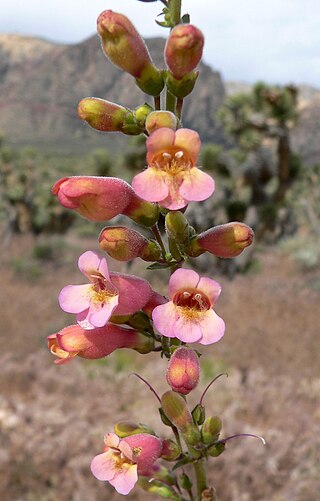
Penstemon bicolor is a species of penstemon known by the common name pinto beardtongue. It is native to the desert mountains and valleys of southern Nevada, eastern California, and western Arizona, where it grows in scrub, woodland, and other local habitat. It is a perennial herb which may exceed one meter in maximum height. The thick, serrated leaves are oppositely arranged and some pairs are fused around the stem at the bases. The inflorescence produces tubular flowers around 2 to nearly 3 centimeters long in many shades of yellow and pink, usually with striping in the throats. The flower's throat is hairy and the staminode just inside is coated in long yellowish hairs.

Penstemon centranthifolius is a species of penstemon known by the common name scarlet bugler. It is native to California and parts of Mexico, where it grows in many types of dry habitat from coast to desert, such as chaparral and oak woodland.
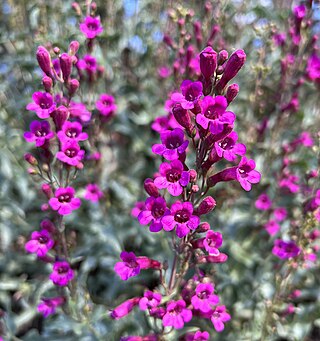
Penstemon clevelandii is a species of penstemon known by the common name Cleveland's beardtongue. It is native to southern California and Baja California, where it grows in mountain and desert habitat such as scrub, woodland, and chaparral. It is a perennial herb with upright, branching stems 70 centimeters in maximum height. The thick leaves are oval in shape, sometimes toothed, and 2 to 6 centimeters in length. The inflorescence produces tubular flowers with expanded, lipped mouths. The flower is pink to magenta in color, up to 2.4 centimeters in length, and somewhat glandular on the outer surface.

Penstemon eatonii is a species of flowering plant in the genus Penstemon, known by the common names Eaton's penstemon and firecracker penstemon. It is native to the Western United States from Southern California to the Rocky Mountains. It grows in many types of desert, woodland, forest, and open plateau habitat.
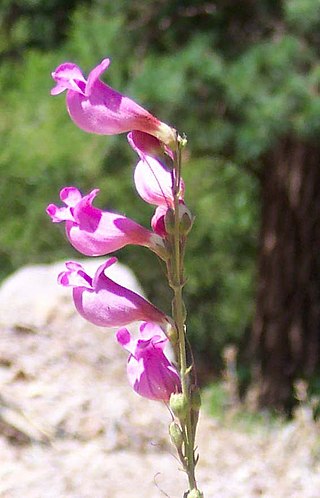
Penstemon floridus is a species of flowering plant in the plantain family known by the common names Panamint beardtongue and rose penstemon.

Penstemon heterodoxus is a species of penstemon known by the common name Sierra beardtongue. It is native to California and western Nevada where it grows in several of the mountain ranges from the Klamath Mountains to the Sierra Nevada - and the slopes and plateaus to the east. It grows in subalpine and alpine climates in mountain forests, meadows and talus.
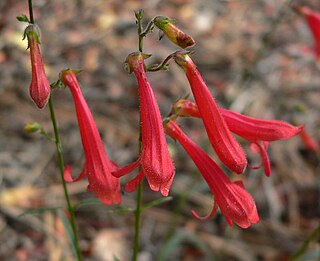
Penstemon rostriflorus is a species of penstemon known by the common names beaked penstemon, Bridge penstemon, or Bridges' penstemon.

Penstemon scapoides is an uncommon species of penstemon known by the common name pinyon beardtongue. It is endemic to Inyo County, California, where it grows in the scrub, woodlands, and forests of the mountain ranges above the desert. It is a clumpy perennial herb forming a dense mat of oval to rounded leaves and erect flowering stems which may exceed half a meter in height. The leaves are pale green and coated densely in hairs. The inflorescence bears tubular flowers each up to 3.4 centimeters in length. The flowers are pale lavender to blue-purple and have yellowish hairs inside their mouths.

Penstemon stephensii is an uncommon species of penstemon known by the common name Stephens' beardtongue, or Stephens' penstemon. It is endemic to California, where it is known only from the mountains of the Mojave Desert region. It grows in scrub, woodland, and sandy clearings, often on limestone substrates. It is an erect shrub which may reach 1.5 meters in height, with many leafy flowering stems. The thin leaves are oval with wide triangular tips and serrated edges. The oppositely arranged pairs fuse about the stem at the bases, sometimes forming a disc. The inflorescence bears glandular, wide-mouthed tubular flowers up to 2 centimeters long in shades of pink or purple. The plant is pollinated by hummingbirds.

Penstemon thurberi is a species of penstemon known by the common names Thurber's beardtongue and Thurber's penstemon. It is native to the southwestern United States and northern Mexico, where it grows in many types of desert and mountain habitat, including sandy flats, chaparral, scrub, and woodlands. It is a shrub growing erect and somewhat rounded in form, reaching around 80 centimeters in maximum height. Many slender stems emerge from its woody base. The leaves are narrow, linear in shape, with edges rolled upward nearly into a tube. The long inflorescence bears funnel-shaped lavender, pink, or pale blue-purple flowers up to 1.5 centimeters in length.
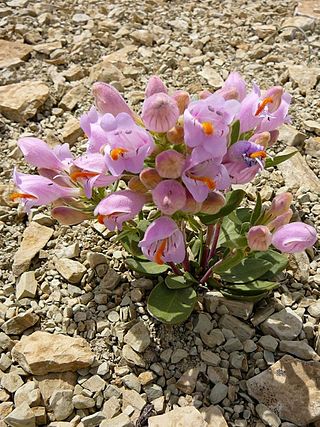
Penstemon grahamii, known by the common names Uinta Basin beardtongue and Graham's beardtongue, is a species of flowering plant in the plantain family. It is native to Utah and Colorado in the United States.
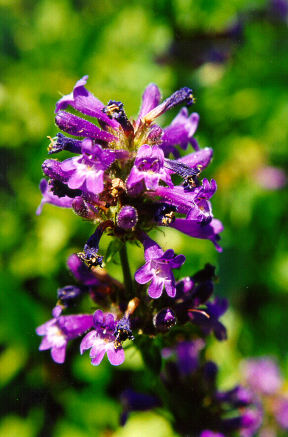
Penstemon attenuatus is a species of flowering plant in the plantain family known by the common names sulphur penstemon and taperleaf beardtongue. It is native to the northwestern United States.

The flora of the U.S. Sierra Nevada alpine zone is characterized by small, low growing, cushion and mat forming plants that can survive the harsh conditions in the high-altitude alpine zone above the timber line. These flora often occur in alpine fell-fields. The Sierra Nevada alpine zone lacks a dominant plant species that characterizes it, so may or may not be called a vegetation type. But it is found above the subalpine forest, which is the highest in a succession of recognized vegetation types at increasing elevations.

Penstemon gairdneri is a species of perennial plant in the Plantaginaceae family with the common name Gairdner's beardtongue. It is native to Washington, Oregon, and Idaho in the western United States.

Penstemon arenicola, commonly known as Red Desert penstemon, is a species of plant from the Western United States. It primarily grows in Wyoming, but it also grows in small areas of Colorado and Utah. It is a short plant known for growing in sand as referenced by its scientific name.





















